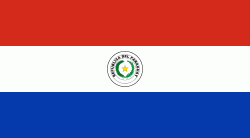Caacupé
 |
The town was founded in 1770 by Carlos Murphy, a grenadier in the service of King Charles III of Spain, although a first settlement existed here from the 17th century.
The city is the seat of the Roman Catholic Diocese of Caacupé. Caacupé is best known as the site of the Virgin of Caacupé, Saint Patron of Paraguay. The Cathedral Basilica of Our Lady of Miracles, Caacupé stands in the centre of the town. A major religious festival is held annually on 8 December in honour of the statuette "Our Lady of the Miracles". This statuette, carved in the 16th century by a devout convert, was miraculously saved from a great flood, and numerous miracles are ascribed to it.
During the rest of the year Caacupé is a quiet provincial town. It has a park with amusements.
Map - Caacupé
Map
Country - Paraguay
 |
 |
| Flag of Paraguay | |
Spanish conquistadores arrived in 1524, and in 1537 established the city of Asunción, the first capital of the Governorate of the Río de la Plata. During the 17th century, Paraguay was the center of Jesuit missions, where the native Guaraní people were converted to Christianity and introduced to European culture. After the expulsion of the Jesuits from Spanish territories in 1767, Paraguay increasingly became a peripheral colony, with few urban centers and settlers. Following independence from Spain in the early 19th century, Paraguay was ruled by a series of authoritarian governments characterized by nationalist, isolationist and protectionist policies. This period ended with the disastrous Paraguayan War (1864–70), during which the country lost half its prewar population and around 25–33% of its territory to the Triple Alliance of Argentina, Brazil and Uruguay. In the 20th century, Paraguay faced another major international conflict—the Chaco War (1932–35) against Bolivia—in which it prevailed. Afterwards, the country came under a succession of military dictators, culminating in the 35-year regime of Alfredo Stroessner, which lasted until his overthrow in 1989 by an internal military coup. This marked the beginning of Paraguay's democratic era, which continues to this day.
Currency / Language
| ISO | Currency | Symbol | Significant figures |
|---|---|---|---|
| PYG | Paraguayan guaranà | ₲ | 0 |
| ISO | Language |
|---|---|
| GN | Guarani language |
| ES | Spanish language |















